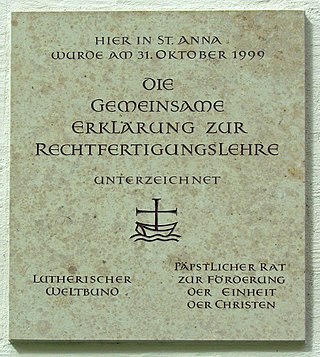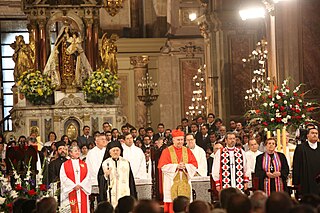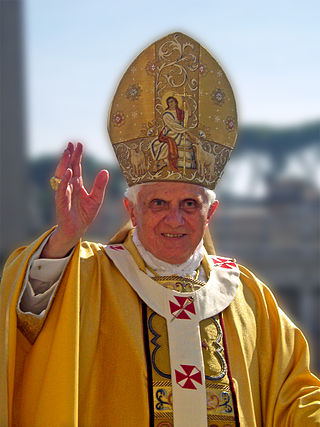Related Research Articles
An ecumenical council, also called general council, is a meeting of bishops and other church authorities to consider and rule on questions of Christian doctrine, administration, discipline, and other matters in which those entitled to vote are convoked from the whole world (oikoumene) and which secures the approbation of the whole Church.

Nostra aetate, or the Declaration on the Relation of the Church with Non-Christian Religions, is an official declaration of the Second Vatican Council. Passed by a vote of 2,221 to 88 of the assembled bishops, this declaration was promulgated on 28 October 1965 by Pope Paul VI. Its name comes from its incipit.

The World Council of Churches (WCC) is a worldwide Christian inter-church organization founded in 1948 to work for the cause of ecumenism. Its full members today include the Assyrian Church of the East, the Oriental Orthodox Churches, most jurisdictions of the Eastern Orthodox Church, the Old Catholic Church, the Lutheran churches, the Anglican Communion, the Mennonite churches, the Methodist churches, the Moravian Church, Mar Thoma Syrian Church and the Reformed churches, as well as the Baptist World Alliance and Pentecostal churches. Notably, the Catholic Church is not a full member, although it sends delegates to meetings who have observer status.

Ecumenism – also called interdenominationalism, transdenominationalism, or ecumenicalism – is the concept and principle that Christians who belong to different Christian denominations should work together to develop closer relationships among their churches and promote Christian unity. The adjective ecumenical is thus applied to any interdenominational initiative that encourages greater cooperation and union among Christian denominations and churches.

The World Evangelical Alliance (WEA) is an interdenominational organization of evangelical Christian churches, serving more than 600 million evangelicals, founded in 1846 in London, England, United Kingdom to unite evangelicals worldwide. WEA is the largest international organization of evangelical churches. The headquarters are in Deerfield, Illinois, with UN offices in New York City, Geneva, and Bonn. It brings together 9 regional and 143 national evangelical alliances of churches, and over one hundred member organizations. Moreover, the WEA includes a certain percentage of individual evangelical Christian churches. As of March 2021, the Secretary General of the WEA is German theologian Thomas Schirrmacher.
The East–West Schism, also known as the Great Schism or Schism of 1054, is the ongoing break of communion between the Roman Catholic and Eastern Orthodox churches since 1054. It is estimated that, immediately following the beginning of the schism, a slim majority of Christians worldwide were Eastern Christians; most of the rest were Western Christians. A series of ecclesiastical differences and theological disputes between the Greek East and Latin West preceded the formal split that occurred in 1054. Prominent among these were the procession of the Holy Spirit (Filioque), whether leavened or unleavened bread should be used in the Eucharist, the Pope's claim to universal jurisdiction, and the place of the See of Constantinople in relation to the pentarchy.
The Catholic–Orthodox Joint Declaration of 1965 was read out on 7 December 1965 simultaneously at a public meeting of the Second Vatican Council in Rome and at a special ceremony in Istanbul. It withdrew the exchange of excommunications between prominent ecclesiastics in the Holy See and the Ecumenical Patriarchate of Constantinople, commonly known as the Great Schism of 1054. It did not end the schism but showed a desire for greater reconciliation between the two churches, represented by Pope Paul VI and Ecumenical Patriarch Athenagoras I.

The Joint Declaration on the Doctrine of Justification (JDDJ) is a document created and agreed to by the Catholic Church's Pontifical Council for Promoting Christian Unity (PCPCU) and the Lutheran World Federation in 1999 as a result of Catholic–Lutheran dialogue. It states that the churches now share "a common understanding of our justification by God's grace through faith in Christ." To the parties involved, this essentially resolves the 500-year-old conflict over the nature of justification which was at the root of the Protestant Reformation. The World Methodist Council adopted the Declaration on 18 July 2006. The World Communion of Reformed Churches, adopted the Declaration in 2017.
Catholic–Lutheran dialogue is a series of discussions which began during July 1964 as an outgrowth of the Second Vatican Council. These gatherings reflect the new openness of the Catholic Church to dialogue with other Christian denominations as well as other religions. These dialogues have been primarily between representatives of the Lutheran World Federation and representatives of the Pontifical Council for Promoting Christian Unity.

The Catholic Church has engaged in the modern ecumenical movement especially since the Second Vatican Council (1962-1965) and the issuing of the decree Unitatis redintegratio and the declaration Dignitatis humanae. It was at the Council that the Pontifical Council for Promoting Christian Unity was created. Those outside of the Catholic Church were categorised as heretics or schismatics, but in many contexts today, to avoid offence, the euphemism "separated brethren" is used.
Branch theory is an ecclesiological proposition that the One, Holy, Catholic, and Apostolic Church includes various different Christian denominations whether in formal communion or not. The theory is often incorporated in the Protestant notion of an invisible Christian Church structure binding them together.
This article describes the relationship between the Seventh-day Adventist Church and other Christian denominations and movements, and other religions. Adventists resist the movement which advocates their full ecumenical integration into other churches, because they believe that such a transition would force them to renounce their foundational beliefs and endanger the distinctiveness of their religious message. According to one church document,

Ecumenical meetings and documents on Mary, involving ecumenical commissions and working groups, have reviewed the status of Mariology in the Eastern Orthodox, Lutheran, Anglican, and Roman Catholic Churches.

Pope Benedict XVI, who led the Roman Catholic Church as Pope from 2005 to 2013, continued manouevring the Church through the dynamics of modernity, which the Church had begun engaging in with the Second Vatican Council. Because the question of religious pluralism is a key issue raised by modernity, ecumenism, the establishment of harmony and dialogue between the different Christian denominations, is a significant concern of a post Second Vatican Council Church. Pope Benedict XVI's approach has been characterised as leaning toward the conservative while still being expansive and engaged, involving the full breadth of Christendom, including the Orthodox Churches and Protestant churches, as well as freshly engaging with other Christian bodies considered by Roman Catholics to be more heterodox, such as the Church of Jesus Christ of Latter-day Saints.
After the Second Vatican Council, Pope Paul VI contributed in two ways to the continued growth of ecumenism and inter-Christian dialogue. The separated brothers and sisters, as he called them, were not able to contribute to the Second Vatican Council as invited observers. After the Council, many of them took initiative to seek out their Catholic counterparts and the Pope in Rome, who welcomed such visits.
Anglican–Roman Catholic dialogue is the historical communication between the Anglican Communion and the Roman Catholic Church, through their ecumenical relations. These were notably shaped subsequent to the Second Vatican Council (1962–1965).
The Dicastery for Promoting Christian Unity, previously named the Pontifical Council for Promoting Christian Unity (PCPCU), is a dicastery within the Holy See whose origins are associated with the Second Vatican Council which met intermittently from 1962 to 1965.
"Roman Catholic" is sometimes used to differentiate members of the Catholic Church in full communion with the pope in Rome from other Christians who also self-identify as "Catholic". It is also sometimes used to differentiate adherents to the Latin Church and its use of the Roman Rite from Catholics of the Eastern Catholic Churches. It is not the official name preferred by the Holy See or bishops in full communion with the pope as a designation for their faith or institution.

Catholic–Eastern Orthodox relations have warmed over the last century, as both churches embrace a dialogue of charity. The Second Vatican Council (1962-1965) ushered in a new era of relations for the Catholic Church towards the Eastern Church, fondly describing the Orthodox as “separated brethren” with valid sacraments and an apostolic priesthood. The Orthodox Church, on the other hand, encouraged local churches to prepare for future dialogue in the Third Pan-Orthodox Conference in Rhodes (1964), and has since engaged in several ecumenical efforts with the Vatican. Significantly, in 1965 Pope Paul VI and Ecumenical Patriarch Athenagoras I of Constantinople mutually lifted their respective excommunications.

The Lima Liturgy is a Christian ecumenical Eucharistic liturgy. It was written for the 1982 Plenary Session of the Faith and Order Commission of the World Council of Churches (WCC) in Lima, Peru and reflects the theological convergences of the meeting's Baptism, Eucharist and Ministry (BEM) document as expressed in liturgy. The liturgy was used again at the closing of a 1982 meeting of the Central Committee of the WCC in Geneva, Switzerland, in 1983 during the Sixth Assembly of the WCC in Vancouver, Canada, in 1991 at the Seventh Assembly of the WCC in Canberra, Australia, and, albeit unofficially, in 1993 at the fifth world conference on Faith and Order in Santiago de Compostela, Spain. Although the Eucharist has not been celebrated at WCC Assemblies after 1991 using the Lima or any other liturgy, the Lima Liturgy has been used in ecumenical events all over the world. For instance, many churches in North America use it on World Communion Sunday.
References
- ↑ Toward Full Communion: Faith and Order and Catholic Ecumenism
- ↑ Reflections on the Joint Working Group between the Roman Catholic Church and the World Council of Churches (1965-2005) Archived 2008-07-09 at the Wayback Machine
- ↑ The challenge of proselytism and the calling to common witness Archived 2008-07-09 at the Wayback Machine
- ↑ From reflection to reception : challenges facing Catholic Church-WCC collaboration (Archived: 23 February 2012)
- ↑ Recent declarations
